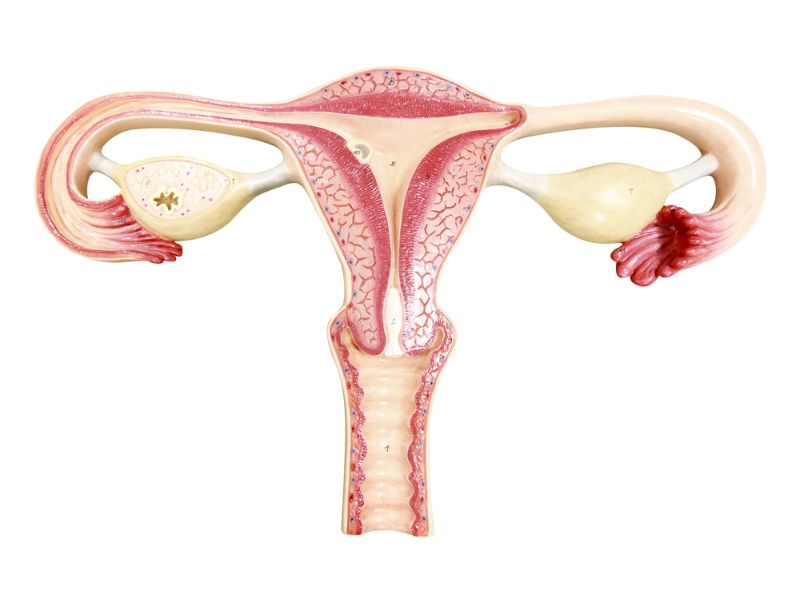7 steps to get pregnant with blocked fallopian tubes
The dream of becoming a mother can come with many challenges, one of which is blocked fallopian tubes. Blockage of this “path” leading to happiness makes many women worried and confused. However, don’t be discouraged! This article will accompany you on the journey of 7 steps to get pregnant with blocked fallopian tubes, so you can confidently welcome the laughter of children in the arms of love.
Signs and symptoms of fallopian tube blockage
Blocked fallopian tubes often do not have obvious symptoms, causing many women to be unaware of this condition. However, some of the following signs may suggest a blockage in the “path” to happy motherhood:
Abdominal pain:
- Lower abdominal pain, especially during sex.
- The pain can be dull or severe, spreading to the hips or back.
Difficulty conceiving:
- This is the most common sign of fallopian tube blockage.
- Trying to conceive for more than 1 year (for women under 35 years old) or 6 months (for women over 35 years old) without success.

Abnormal bleeding:
- Bleeding between menstrual cycles.
- Bleeding after sex.
Miscarriage:
- Blocked fallopian tubes can increase the risk of miscarriage.
- Repeat miscarriages can be a sign of a blockage.
Other signs:
- Some women may experience symptoms such as:
- Abnormal vaginal discharge.
- Frequent urination.
- Pain when urinating.
- Constipation.
- Chest pain.
Note:
- Not all women with blocked fallopian tubes have the above signs.
- Some cases may have no symptoms at all.
The role of the fallopian tubes in conception
The fallopian tubes, also known as the uterine tubes or cervical tubes, play an important role in conception and pregnancy. Here are some of the main roles of the fallopian tubes during conception:
- Egg transport: The fallopian tube is where eggs produced from the ovaries move to the uterus. After the egg is released from the ovary, it is moved through the fallopian tube by mechanisms such as muscle waves and other transport mechanisms.

- Place of contact between egg and sperm: The fallopian tube is where the egg and sperm meet to carry out the fertilization process. After the egg is released from the ovary, it moves down the fallopian tube, where it can be fertilized by sperm if available.
- Environment for conception: Fallopian tubes create a suitable environment for conception to take place. This includes providing secretions to protect and nourish the eggs and sperm during migration.
- Embryo migration: After fertilization occurs, the formed embryo will continue to move down to the uterus through the fallopian tube. This process can take a few days and usually ends with the embryo attaching to the uterine wall for further development.
Overall, the fallopian tubes play an important role in the conception process by facilitating the meeting between egg and sperm, as well as providing the environment for conception and embryonic development.
Find out the cause of fallopian tube blockage
Blocked fallopian tubes are one of the common reasons why women have difficulty conceiving. Understanding the cause of blockage helps you prevent or detect it early to welcome your baby’s laughter.
Here are some common causes of fallopian tube blockage:
- Infection: Sexually transmitted infections (STD) such as Chlamydia and gonorrhea are the leading cause of fallopian tube blockage. Pelvic inflammatory disease caused by other bacteria can also lead to obstruction.
- Birth defects: Some women may have birth defects that cause the fallopian tubes to not fully develop or become blocked.
- Surgery: Abdominal or abdominal surgery can damage the fallopian tubes, leading to blockage.
- Endometriosis: Endometriosis is a condition in which endometrial tissue grows outside the uterus, which can affect the fallopian tubes and cause blockage.
- Other factors
- Age: Women’s fertility declines with age, increasing the risk of fallopian tube blockage.
- Smoking: Smoking can affect reproductive health and increase the risk of fallopian tube blockage.
7 steps to get pregnant with blocked fallopian tubes
When dealing with blocked fallopian tubes, it can be challenging to conceive naturally. However, there are several steps you can take to increase your chances of getting pregnant:
- Consult with a fertility specialist: The first step is to seek advice from a fertility specialist or reproductive endocrinologist. They can assess your specific situation, including the extent of blockage and any underlying causes, and recommend appropriate treatment options.
- Identify the cause of blockage: Understanding the underlying cause of your blocked fallopian tubes is crucial for determining the best course of action. Common causes include pelvic inflammatory disease (PID), endometriosis, previous surgeries, or pelvic infections.
- Undergo diagnostic tests: Your doctor may recommend various diagnostic tests, such as hysterosalpingography (HSG) or laparoscopy, to evaluate the condition of your fallopian tubes and identify any blockages or abnormalities.

- Consider fertility treatments: Depending on the severity of the blockage and other factors, fertility treatments such as in vitro fertilization (IVF) may be recommended. IVF involves retrieving eggs from the ovaries, fertilizing them with sperm in a laboratory setting, and transferring the resulting embryos into the uterus.
- Explore surgical options: In some cases, surgical procedures such as tubal reanastomosis or tubal cannulation may be performed to remove blockages or repair damaged fallopian tubes. However, the success rates of these procedures can vary depending on various factors.
- Address underlying health issues: It’s essential to address any underlying health issues that may be contributing to your blocked fallopian tubes, such as infections or endometriosis. Your doctor may recommend medications or other treatments to manage these conditions.
- Lifestyle modifications: Making healthy lifestyle choices can also improve your fertility and overall reproductive health. This includes maintaining a balanced diet, managing stress, exercising regularly, avoiding smoking and excessive alcohol consumption, and maintaining a healthy weight.
So you know the 7 steps to get pregnant with blocked fallopian tubes. Fallopian tube blockage is not necessarily a complete barrier to pregnancy. There are many treatments that can help couples conceive, including the use of medical methods and even surgical methods. However, it is most important to consult a doctor or fertility specialist to evaluate your condition and choose the most suitable treatment method.













